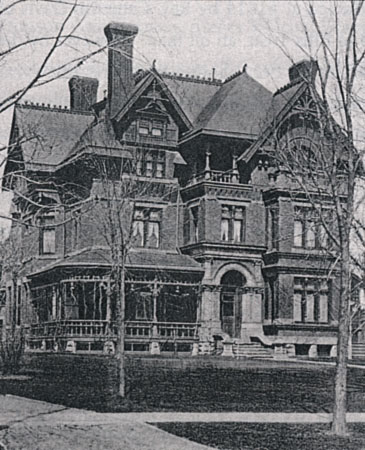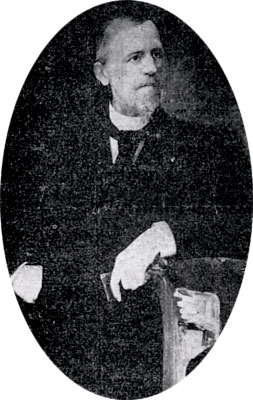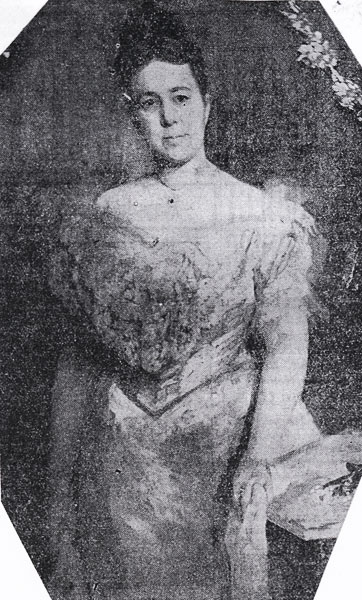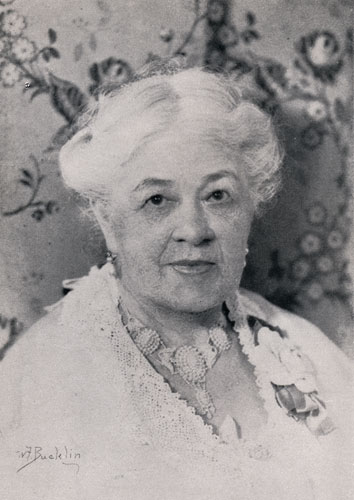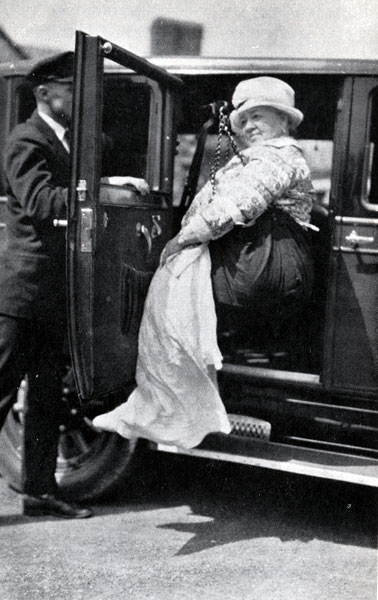Mrs. Satterfield and her Happy Home
"There isn't another house in town that has harbored more happiness, or meant more to the generations that have occupied it." So said Matilda Martin Satterfield in 1928 about the mansion she built with her husband in 1880-1883. Matilda Martin was born in Allentown, Pennsylvania, the fourth of eight children. Her father was a homeopathic physician who took her along when he visited patients as his assistant. "I was always a pet with my father, and he never hesitated to let my sister and five brothers know it." Their mother was a different matter. "..as each of us reached school age, we were awakened at five o'clock to assemble about a round table for family worship, mother reading from the cumbersome, old, leather-bound Bible...This was followed by a period of intensive study, with mother assisting each of us in turn...By seven o'clock we were at the breakfast table, where scrapple and sausage, huge pans of fried potatoes, and buckwheat cakes with black molasses stood ready to cope with our youthful appetites...Then came a short interval for piano practice. A little board was fitted to the keyboard to keep the wrist raised, and there again sat the blessed mother with a tiny stick which she occasionally applied as a gentle reminder of carelessness. At last, all duties completed, the older children bundled up the little ones and off we went to school." |
Her father was adamant that Matilda not engage in adolescent love affairs that would interfere with her schooling. First she was sent to a boarding school when she became infatuated with a young man living with her family as he learned medicine. She subsequently was found to have another love interest at that school and was finally sent to an all-girls boarding school. By the time she graduated, she had added fluency in Latin and French to her second language, German. And when she was 23 years old, she was introduced to John Satterfield, 13 years her senior and already president of the Oil City Bank and the Union Oil Company. She said it was love at first sight. Her family approved. They were married in 1876 and spent several years years in Titusville, Pennsylvania until they decided to move to Buffalo in 1880 where John had business friends. The rapidly growing city afforded more options for a wealthy man and more culture for Matilda and their growing family. |
John Satterfield Image source: Buffalo Times The land at 1022 Delaware Avenue had a house standing, built around 1869 by Calvin Phelps. After a year of searching, the Satterfields settled on this address and demolished the home. They had a new more fashionable one designed by Milton Beebe, a southern tier builder/architect then expanding into Buffalo. Construction of the red brick, Queen-Anne style mansion took nearly three years. The long drawing room was finished in white mahogany; the stairway featured a window by John LaFarge. On the third floor was a ballroom and billiard room. Matilda Satterfield oversaw every detail of the interior decoration, utlizing the skills of Boston decorators. She said, "Every detail was planned according to my special choice and desires." Her husband laid a cornerstone in the house, into which he placed a number of "trinkets." Their two children, John Martin and Mary (later called Marie) completed their happy family. |
Matilda Martin Satterfield portrait. Image source: Buffalo Times From the start, the Satterfields entertained cheerfully and often. Matilda had no difficulty making new friends, one of whom was Anna Katherine Green. Their grounds extended from Delaware to Atlantic Street and featured gardens, fruit and elm trees planted by John Satterfield, tennis courts, and a baseball diamond which in later years was opened to neighborhood boys. There was also a large garage which stored the "picnic carriage." The Satterfields were the first to regularly picnic at Windmill Point in Canada and had a carriage especially designed to carry their guests and all the supplies for an outing. In 1893, John Satterfield was not in good health and determined to establish a trust bank that would provide for families of the well-to-do after the wage earner's death; he was thinking of his own family, especially. To this end, he asked his "Tillie" to plan a dinner party for sixteen guests, some of whom were to be officers in the new bank. For this special occasion, John Satterfield suggested that his wife buy a new dress as expensive as she wanted. As a result, she "sped" to New York's House of Worth and returned with a sea foam brocade gown made of "the old 'standing alone' silk." She later had the portrait at right painted of her in this dress; the artist, Benjamin Constant, came from France for the project. The founding of the Fidelity Trust Company was John Satterfield's last business venture. In 1894, his doctors suggested he go abroad for convalescene. He died in Paris in April at the age of 55. In her memoir, Matilda said, "Now began for me a new and very serious life. I had been treated in the past like a child, and knew nothing of business. Vicissitudes crowded in upon me in the care of the estate." Forty-four years later, in 1938, Matilda Martin Satterfield published her memoirs; she was 86. Her book, "Glad Did I Live," was written in around five weeks in a hotel room in Boston, Massachusetts, a city she selected because she knew no one there. Each day she dictated to a secretary the vivid details of her life. Most of the book is devoted to the decades after her husband's death. She details her response to the awful news that her 20-year old son, John M., was deathly ill of typhoid in Constantinople, Turkey. In "exactly eleven days and twelve hours," she was at his side with her bag of homeopathic remedies. He slowly recovered. |
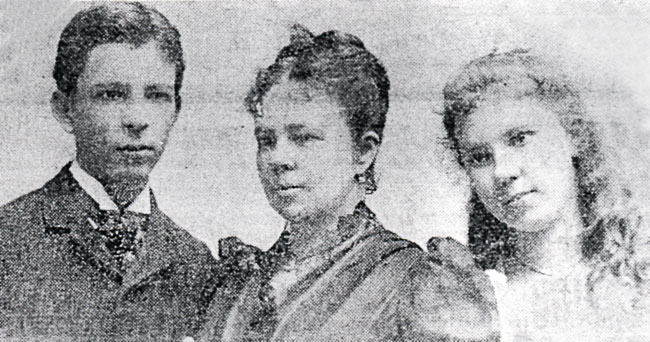
The widow Matilda Sattefield with her children, John, 18 and Mary(Marie), 15.
Matilda Martin Satterfield, 1938. Her daughter, Marie, married a grand-nephew of Empress Elizabeth of Austria, Count Franz Joseph von Larisch, somewhat against her mother's wishes. Mrs. Satterfield traveled to Austria and described her travels around the continent, meeting royalty in the last years before the calamity of World War 1 destroyed that way of life. Marie's marriage to the Count would eventually fail and her mother advised that she leave him, which she did. Later, while at home in Buffalo, news came of the assassination of Archduke Ferdinand and his wife, friends of Marie's, which precipitated the start of war in 1914. Marie, now divorced and engaged to the Englishman who would become her second husband, asked her mother to come to Hamburg, Germany, to meet him. Thus began Mrs. Satterfield's adventures in wartime Germany. Unable to leave because she had no money, she appealed to son John in the States to send cash which he did by a traveler. With kindnesses and good luck, she was able to reach London. Her daughter's two small sons would not be allowed to remain in England while it was at war with Germany, so they came to the States to live with grandmother in an apartment. 1022 Delaware was occupied by son John, his wife, their daughter and son at the time. |
Mrs. Satterfield demonstrating her "crane." Image source: Glad Did I Live." In 1925, Mrs. Satterfield injured her back and was unable to walk after tripping over a chair in her old home on Delaware Avenue. So that she could continue to attend functions, her son invented what she called her "crane" which moved her out of the automobile and into her wheeled chair. She became a charter member of the Western New York branch of American Pen Women and attended Breadloaf in Vermont, not seriously intending to become a writer. But she changed her mind and contributed articles to newspapers and magazines. On November 28, 1939, the Western New York branch of the American Pen Women unanimously chose "Glad Did I Live" for the Founder's Award. It was given to a member achieving the greatest literary accomplishment of the year. She continued to travel despite what she called her "predicament" and every year attended the Bach Festival in Bethlehem, Pennsylvania. At the end of her memoirs, Matilda Martin Satterfield wrote, "...it seems to me that I have been singularly blessed and favored by destiny...Life is for all of us a thrilling, mysterious adventure, and Death may itself offer experience undreamed of by the profoundest philosophers." When she died in 1944 at age 92, the Buffalo Courier-Express described her as an "author and symbol of the charm and courage of a passing generation." She left five grandchildren and six great-grandchildren, and her memoirs. |
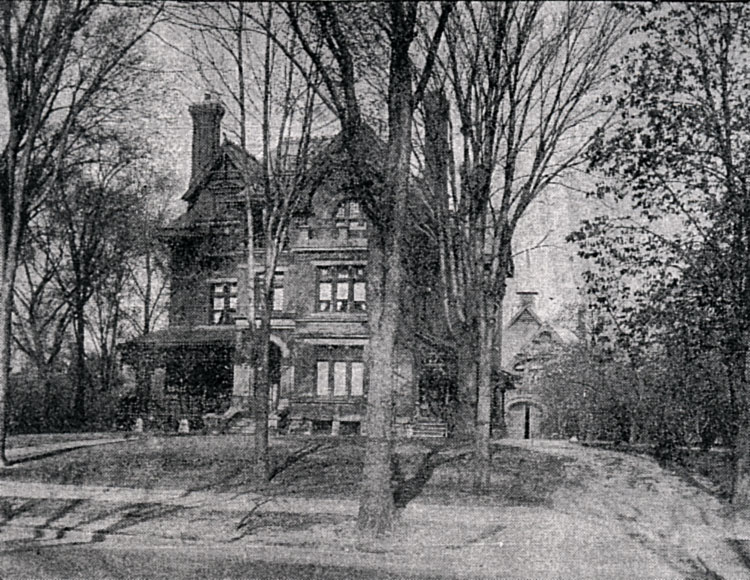
1926 view. Image source: Buffalo Times
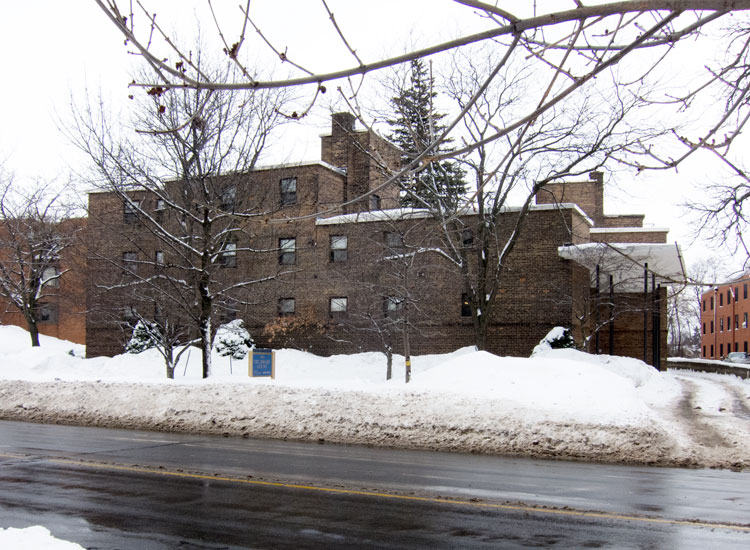
2015 view.
The mansion at 1022 Delaware was sold for $100,000 to the new Town Club in 1926. The Club, which hosted its first meeting in the home, planned to demolish the home and construct a new clubhouse. This did not occur; the Club established itself in the Kellogg mansion at 805 Delaware in 1927. Thirty-nine years after it was constructed, the mansion at 1022 was demolished. Mrs. Satterfield kept the LaFarge window from the house. The land lay vacant until 1947 when two Buffalo investors purchased the property with plans for an apartment building. In 2015, the site is occupied by those apartments.
